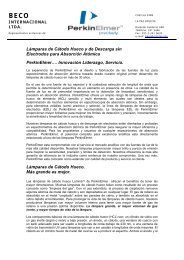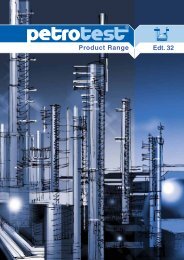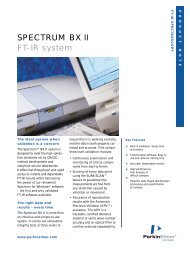General Catalogue Chemistry - BECO Internacional LTDA.
General Catalogue Chemistry - BECO Internacional LTDA.
General Catalogue Chemistry - BECO Internacional LTDA.
Create successful ePaper yourself
Turn your PDF publications into a flip-book with our unique Google optimized e-Paper software.
chromatography<br />
HPLC<br />
in Education and Training<br />
HPLC experiment setup using the CPS system<br />
High performance liquid chromatography<br />
(HPLC) is one of the latest chromatographic<br />
separation processes, which, due to its versatility,<br />
is currently enjoying increasing popularity.<br />
HPLC can be used in a variety of areas and analytical<br />
problems in biology, environment protection<br />
and chemistry.<br />
Equipment list<br />
HPLC-chromatography<br />
Quantity Description Cat. No.<br />
1 CPS HPLC pump 665 485<br />
1 CPS-HPLC column support 665 481<br />
1 Separating column Sl RP-18 665 4791<br />
1 CPS HPLC reservoir 665 487<br />
1 HPLC basic kit 665 4801<br />
1 Set of hoses and septa for HPLC 665 488<br />
1 CPS Flow-through-photometer for HPLC 665 486<br />
1 CPS mains distributor 665 497<br />
1 Connecting lead, Ø 2.5 mm, yellow/green, cm long 501 41<br />
1 Reagent and shipping bottle: 500 ml 661 203<br />
1 Set of hoses and septa 665 488<br />
1 Sensor-CASSY 524 010<br />
1 CASSY Lab 524 200<br />
1 Panel frame, C50, two-level 666 425<br />
additionnally required:<br />
1 PC with Windows 95 or 98 or NT<br />
48 LEYBOLD DIDACTIC · GENERAL CATALOGUE CHEMISTRY<br />
Natural products, organic polymers and biopolymers,<br />
pharmaceuticals, dyes, antioxidants, insecticides,<br />
protein mixtures, nucleic acid fragments,<br />
fatty components, pheromones or plant<br />
pigments, are just some of the substances suitable<br />
for analysis using HPLC.<br />
HPLC is capable of far higher separation than<br />
traditional column chromatography. The higher<br />
pressures substantially reduce the time required<br />
for analytical separation. In routine measurements,<br />
separation requires only a few minutes,<br />
no longer hours or days.<br />
A further result of the higher operating pressures<br />
is, that extremely fine-grained carrier materials<br />
can be used. This increases the exchange<br />
between the stationary and mobile phases (the<br />
number of “theoretical plates“ increases<br />
substantially).<br />
An inexpensive low-pressure system (max. 10<br />
bar) has been designed especially for educational<br />
use. HPLC is recommended for use in advanced<br />
secondary science courses, as well as in occupational<br />
training.<br />
The eluent (the mobile phase) is transported<br />
from the liquid reservoir through the pump and<br />
the separating column (containing the stationary<br />
phase). The sample to be analyzed is transported<br />
to the column via the column head. The end of<br />
the column is connected to a detector, and this<br />
signal is registered by recorder. Alternatively,<br />
using a computer makes for more efficient<br />
recording and evaluation of measurements.<br />
The LEYBOLD DIDACTIC HPLC system is<br />
based on a new concept for fast column chromatography<br />
using pressures of up to 6 bar. It comprises<br />
individual functional modules which,<br />
depending on necessity, can easily be assembled<br />
to create the entire HPLC system. All components<br />
are mounted on training panels. A wide<br />
variety of separating columns is available. An<br />
aeration pump with highly constant pumping<br />
capacity serves as the pump for this system. A<br />
UV/VIS-photometer with flow-through cell, or<br />
even more effective, the CPS flow-through photometer<br />
can be used as the detector. Control and<br />
regulation of the entire system is carried out<br />
using the CASSY interface device.<br />
Comprehensive instructions enable easy installation<br />
of the system. Experiment instructions for<br />
HPLC in education and training can be found in<br />
the manual “Biochemistry II“ (> 668 102).






